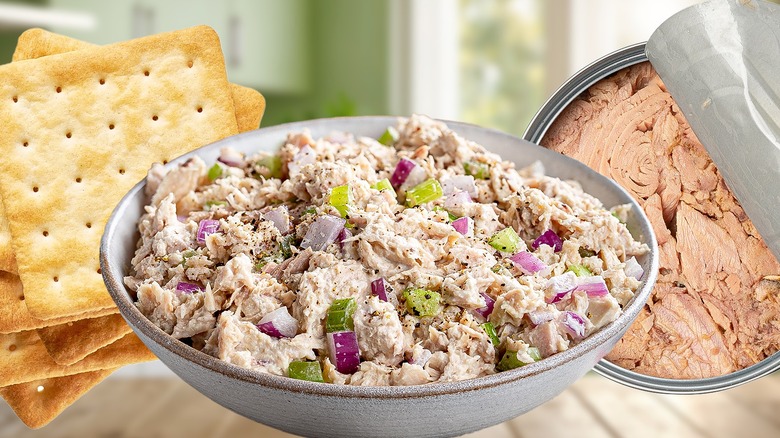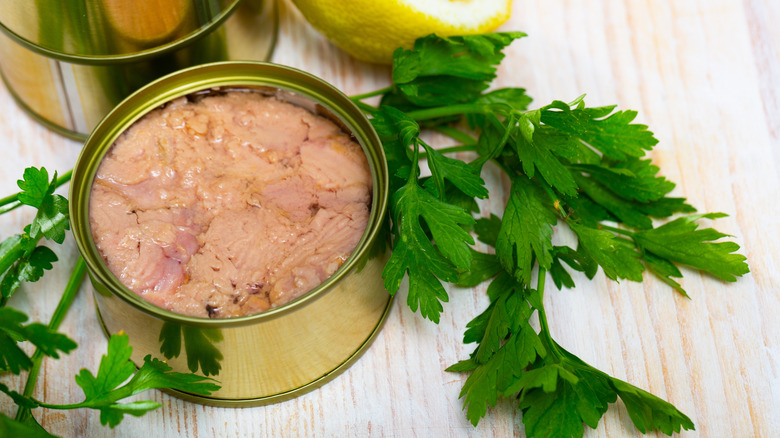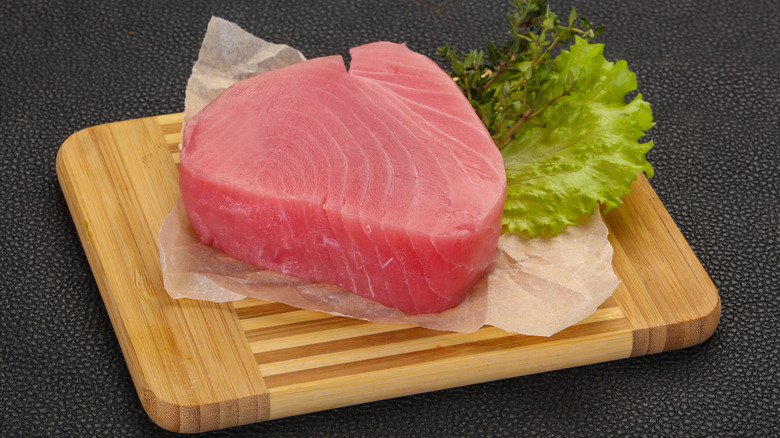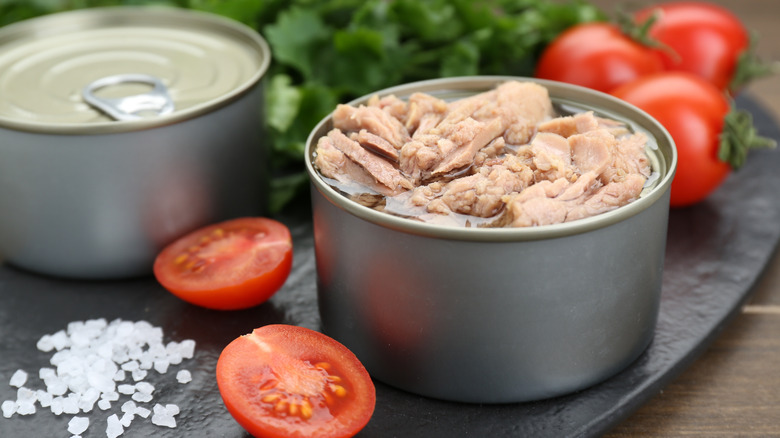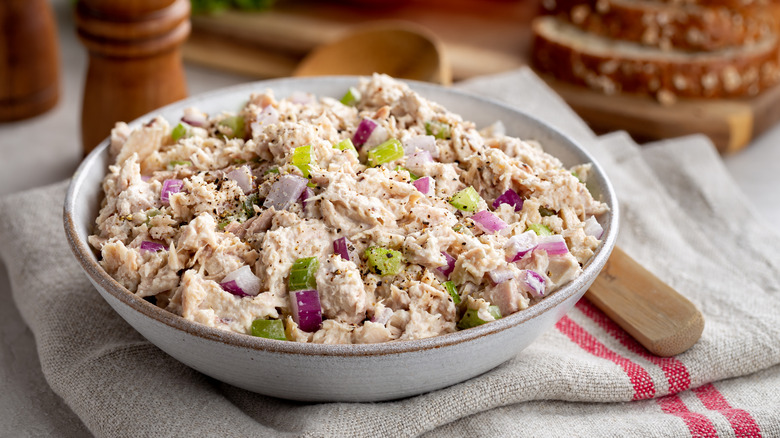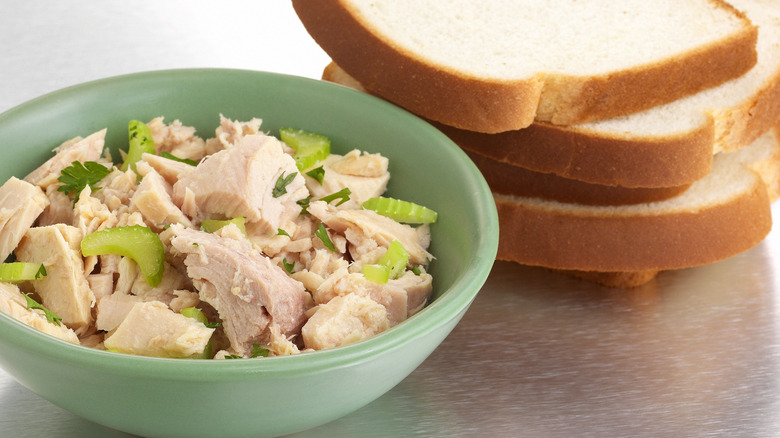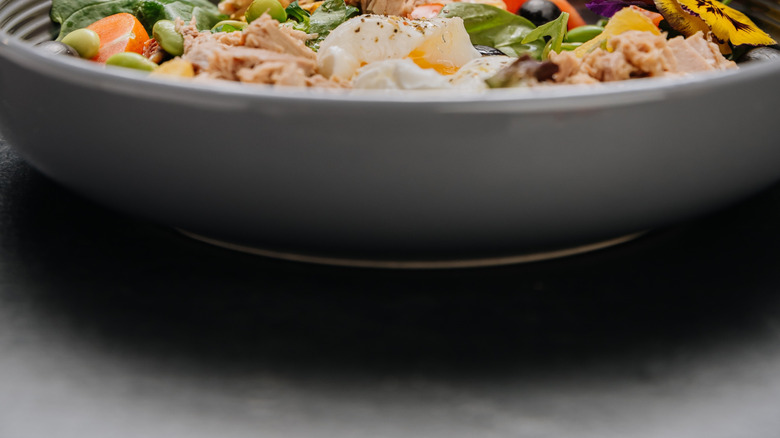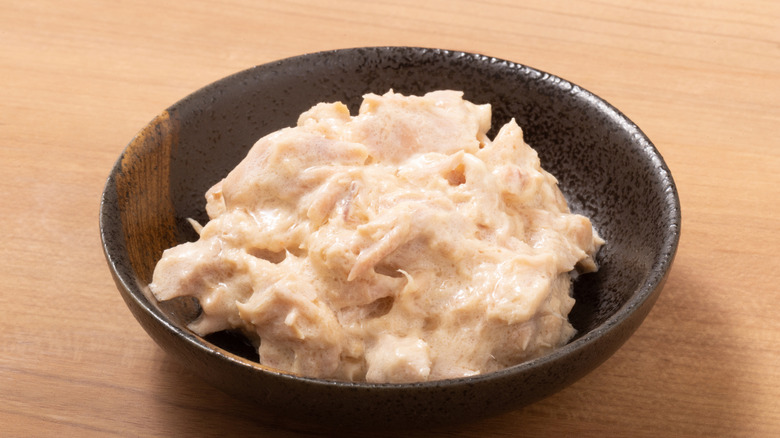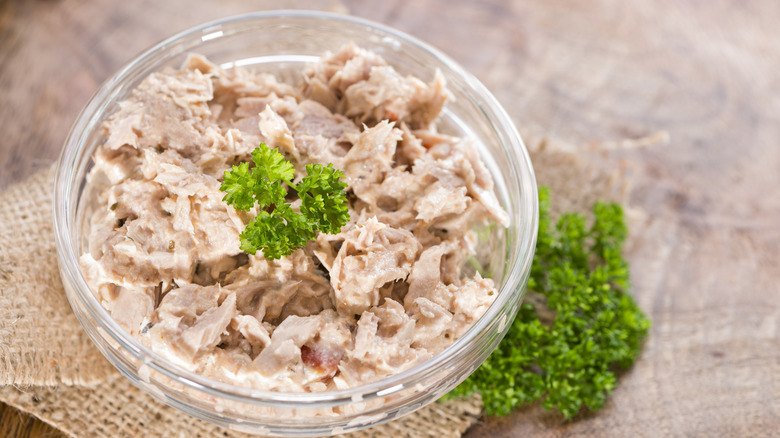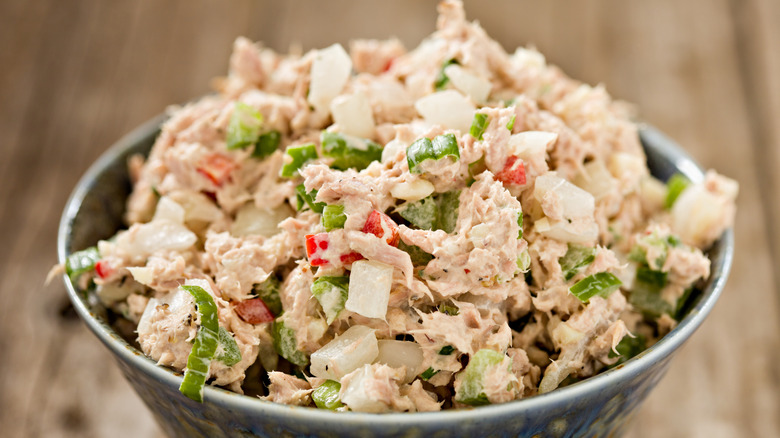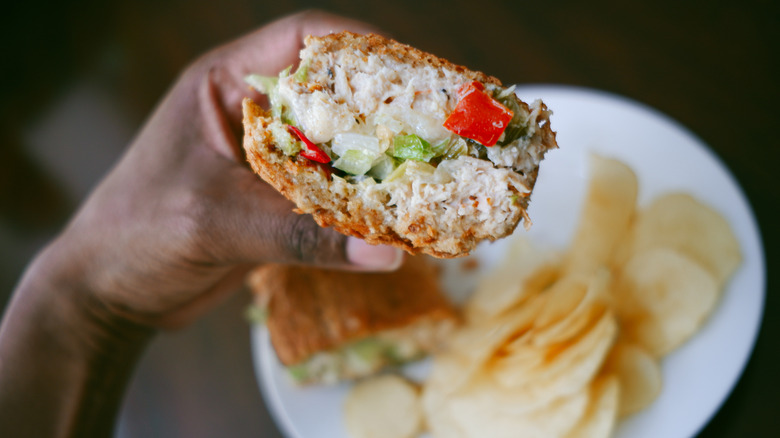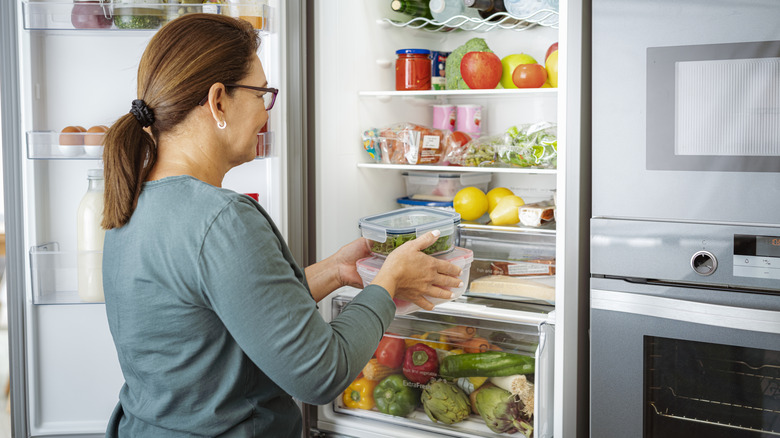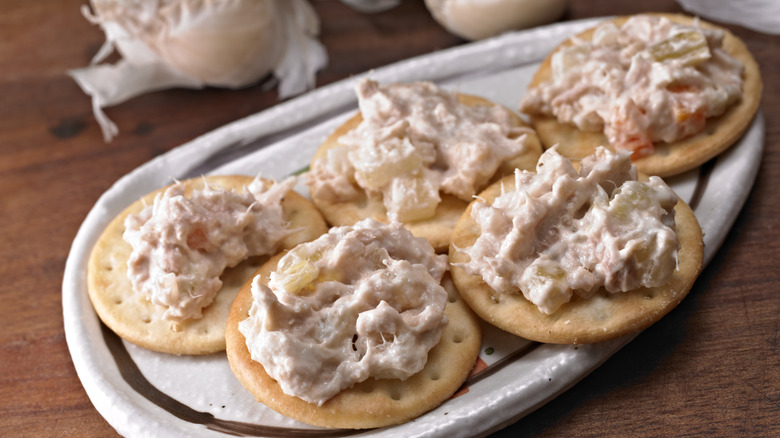Please Stop Making These 12 Common Mistakes With Your Tuna Salad
Tuna salad is such a classic dish that it's hard to believe that it only became popular in the 20th century. Its origins go back to the 19th century when people would take leftover fish and meat from dinner, mix it with mayo, and serve it on lettuce for lunch the next day. That's where the "salad" part of the dish came from. Canned tuna became the go-to meat for mayo-based lunch salads in the early 1900s thanks to a huge marketing push from a popular fish canning company. When sliced bread entered the picture a short time later, tuna salad sandwiches became a working class lunch staple.
There are several reasons tuna salad is still so popular today. It's easy-going, tasty, and nutritious. Plus, it's not overly complicated to prepare. Just grab some tuna, mix in some mayo, add some crunchy bits and seasoning, and you're good to go. However, there are a few missteps you can make along the way that can result in a sub-par tuna salad. Get a few of the elements wrong and you can end up with a salad that's too dry, too watery, weirdly textured, or just plain bland. If you want to elevate your tuna salad, these are a few common mistakes to avoid.
1. Using the wrong type of tuna
Stroll through the canned fish section of the grocery store and you'll likely find several types of canned tuna. You can choose from albacore, yellowfin, skipjack, tongol, or bigeye tuna. Then there is solid, chunk, or flaked tuna. Finally, you can decide whether you want your tuna packed in oil, brine, or water, and salted or unsalted. You may think that cans of tuna are all pretty much the same, but each has different characteristics it can bring to your tuna salad.
Many people prefer albacore (also called white tuna) for tuna salad because it has a milder taste and firmer texture other types of tuna. However, if you like a stronger tuna flavor, you may want to look for light tuna. It's typically made from skipjack, yellowfin, or a combination of both. Solid tuna, chunk tuna, and chunk light tuna will give you larger pieces. Flake tuna has a finer texture, which is great for mixing but it can also make your tuna salad slightly mushy. Many people say tuna packed in oil is best for tuna salad because it provides richness you don't get from water-packed tuna.
2. Not considering fresh tuna or gourmet options
Canned tuna is the cheapest and most convenient choice for making tuna salad, but fresh tuna can take your salad to a whole other level. Top-notch tuna tends to be meatier and more buttery than canned tuna. Plus, fresh tuna typically has far less sodium than canned tuna. The key is to choose a high quality tuna steak like albacore or yellowfin. You can brine or marinate your tuna first to impart some flavor. Then you can cook it on the grill, sauté it, steam it, or bake it in the oven. Let it cool, then shred it with a fork or chop it into chunks.
Gourmet tuna is another option that can amp up the flavor and texture of your tuna salad. There are several companies that sell high-quality tuna that chefs swear by. Many only sell pole or line-caught tuna and pack the fish in flavorful olive oil or vibrant sauces. Ortiz, Tonnino, and Genova are a few well-known brands. David Chang's favorite canned tuna is Dongwan tuna in a hot gochujang chile sauce. You can also find tuna packaged in glass jars, which allows you to see the consistency and quality of the fish right from the get-go.
3. Improperly draining the tuna
One of the most common mistakes people make with canned tuna is not draining it properly. Whether your tuna comes packed in water or oil, you want to make sure that all of the liquid is drained out of the tuna before you make your salad. Otherwise, the liquid will water down the mayo and make your tuna salad a wet mess. The best way to do this is to place the tuna into a fine mesh strainer set over a bowl or the sink. You can use a fork to press the tuna so that all the liquid drains out.
If you're using tuna packed in oil, you may want to save the oil to use in other dishes. You can make a zippy vinaigrette for a fresh salad or use it as sauté oil for a seafood dish. If you opted for tuna in water, there's not much you can do with the leftover water except maybe feed it to your pets. In that case, you can simply use the lid draining method. Open the lid of the tuna, then hold the tuna over the sink and press the lid firmly into the can to drain the water out. Make sure you press evenly on both sides of the lid to ensure all the liquid drains out.
4. Neglecting to add textural contrast
Whether you use canned or fresh tuna, the meat is going to be soft. Add mayo and you have a mixture that can be rather mushy and boring on its own. A good tuna salad should have at least one crunchy ingredient to create textural variation. You may also want to add a variety of textures to give your tuna salad complexity. Some of the most common ingredients people add to tuna salad include celery, onions, capers, bell peppers, and pickles.
Don't be afraid to get creative when adding some crunch to your tuna salad. Sometimes uncommon ingredients can work surprisingly well. For example, Martha Stewart's secret ingredient for stellar tuna salad is diced apples. It may sound strange, but the sweetness of the fruit actually enhances the savory elements of the fish. Gordon Ramsay elevates his tuna salad with French green bean salad, tapenade, and a poached quail egg. Matthew McConaughey called himself a "tuna fish salad master maker" on the 2 Bears, 1 Cave podcast and said that he adds red onions, dill gherkins, crispy jalapeño chips, corn kernels, diced apples, and frozen peas.
5. Making it too chunky
While you want some textural variation in your tuna salad, you also want to make sure that all of the ingredients are well incorporated. Unless you're going for a chopped tuna salad with greens, you don't want big chunks in the salad because it will make the salad more difficult to eat. Plus, big chunks can overpower the other ingredients and give the salad an unpleasant texture. Ideally, you want to be able to taste all of the flavors you're including in the salad in each bite.
The first thing you want to do when making tuna salad is use a fork to fluff your canned tuna. This will break up the chunks and make it easier to mix in your other ingredients. Then you want to finely dice your vegetables with a sharp knife. Some people use a food processor to chop the vegetables or a grater to break down harder ingredients. You can also peel your celery to get rid of the stringy parts. Once you have all your ingredients in the bowl, be sure to mix it well so that all of the ingredients are spread evenly throughout the salad.
6. Leaving out an acidic element
If you find that your tuna salad is bland or lacking freshness, it may be because you haven't added an acidic component. Acid can help balance the mildness and fattiness of the mayo and the richness of the tuna. It can also lift up the flavor profile, giving your salad more vibrancy. If your canned tuna is packed in brine, you may already be getting a touch of tang. If not, there are plenty of ways you can add acidity to your tuna salad.
Some common acidic ingredients that people use in tuna salad include lemon juice, mustard, and vinegar. You can also swap out the mayonnaise for a creamy ingredient with some acidity like sour cream or Greek yogurt. Ingredients such as pickles, olives, and capers can add acid and textural contrast. Jalapeños and banana peppers are also great acidic add-ins if you can handle the heat. Just be sure not to overdo it because too much acid can make your tuna salad overly sour. The key to getting the perfect amount of tang is to add the acidic ingredients slowly and taste as you go.
7. Overloading on wet ingredients
Tuna salad recipes may vary considerably, but if there's one thing that most call for is mayonnaise. The mayo acts as a binder to hold the tuna and other ingredients together and gives the salad a delicious creaminess. However, too much mayo will turn your tuna salad into a gloopy mess. To avoid ending up with a salad swimming in mayo, it's best to start small. Many people recommend about 1 tablespoon of mayo per can of tuna. Mix in your mayo, then monitor the consistency. You can always add more, but taking it out once it's in is next to impossible.
Keep in mind too that any wet ingredients you add will make the tuna salad runnier. Go light on the liquids like lemon juice and mustard. You may want to pat down wet vegetables like tomatoes, capers, or cucumbers before adding them to your tuna salad. If you accidentally go overboard with the wet elements, you may need to add more tuna or other dry ingredients to help the mayonnaise spread further. Extra creamy tuna salad can work with sandwiches, but you may want to use thick bread. Toasting the bread can also prevent soggy sandwiches.
8. Underseasoning the salad
Any chef will tell you that seasoning is the key to making any dish truly spectacular and tuna salad is no exception. Tuna is flavorful on its own, but mayo tends to be very mild, so you need something extra to enhance the flavor of the fish. At the very least, your tuna salad needs some salt to bring out the savory notes of the fish and the sweetness of the mayo. As we mentioned earlier, acidic ingredients like lemon juice and mustard can make your salad pop. You can also add spices like oregano, thyme, or cumin.
If you want to give your tuna salad more character, consider using everything bagel seasoning. The combination of salt, onion, garlic, poppy seeds, and sesame seeds will give your salad salty and savory notes as well as a bit of crunch. Hot sauce and chile powder can amp up the heat level, while sweet relish can offset the richness of the mayo and fish. You can also take inspiration from different international cuisines. For example, curry powder can give your tuna salad an Indian twist and wasabi can add a Japanese touch.
9. Skipping fresh ingredients
One of the easiest ways to take your tuna salad from bland to brilliant is adding fresh ingredients. In addition to diced vegetables, you may want to consider incorporating some fresh herbs. The bright flavors and aromas of the herbs will add another layer of depth to your salad. Moreover, herbs will add pops of color and additional texture. Parsley is a classic tuna salad add-in that won't detract too much from the other flavors of the tuna salad. You can also add dill to your tuna salad, try tarragon for a citrusy herbaceous twist, or throw in some chopped basil.
Another area where you can go fresh with your tuna salad is your mayo. It may seem like a daunting task to make mayo at home, but it's not actually that complicated. All you need is oil, eggs, mustard, and vinegar or lemon juice. You can use a hand blender or food processor to whisk together the eggs, mustard, and vinegar. Then you slowly add the oil and blend it until the mixture is thick and creamy. Many people swear by homemade mayonnaise, saying that it tastes far better than the store-bought variety. Plus, it doesn't contain any preservatives.
10. Not balancing flavors
With all this talk about adding extra ingredients to your tuna salad, you might be thinking we're encouraging you to throw everything but the kitchen sink into the mix. That's not exactly true. There's a fine line between amping up the flavors and going overboard. What you really want is to ensure that all of the flavors complement one another and no one ingredient overpowers the salad. Balance is the key to any dish, even one as basic as tuna salad.
The trick to balancing out the flavors in your tuna salad is to think about what flavor notes each ingredient brings to the mix. If you're adding sour elements like lemon juice and mustard, you may want to balance that with something sweet like sweet pickle relish or a sprinkle of sugar. Salty ingredients can bring out the sweetness of the mayo and counter bitter flavors like parsley. If you go too salty, you can correct that with a bit of sugar or acid. It's best to taste test your tuna salad as you're making it so that you can make adjustments to achieve the perfect balance of flavors.
11. Forgetting to chill the salad
One of the reasons that tuna salad often tastes better at restaurants than it does at home is because restaurants typically chill their tuna salad. There are a few reasons for this. First, refrigerating the salad gives it time for the flavors to meld together. Plus, chilled tuna salad is firmer than room temperature salad. This helps it stay together in a sandwich and allows for easy scooping onto crackers. In addition, the cool temperature gives the sensation of freshness, which enhances the experience of eating the fresh ingredients like crunchy celery and herbs.
If you simply can't wait to eat your tuna salad or need to leave it out for an event like a potluck dinner or barbecue, it's important to not keep it out too long. The FDA warns against keeping perishable foods at room temperature for longer than two hours. That time goes down to an hour if the temperature is above 90 degrees Fahrenheit. Bacteria grow quickly between 40 and 140 degrees Fahrenheit, so you don't want to give those germs time to proliferate. In terms of how long tuna salad can last in the fridge, three or four days is a good rule of thumb. Most people do not recommend freezing tuna salad because the texture can be soggy when it thaws.
12. Serving the salad with boring bread or crackers
Plain white bread is pretty standard for tuna salad sandwiches, but it can also be somewhat sad. It just doesn't have enough heft to hold a whole lot of tuna salad and it can get soggy pretty fast. If you want to upgrade your tuna salad sandwich, consider using thick whole wheat bread for extra flavor and holding power. A pillowy bun can also work well and give a similar sensation to white bread but with more bite. You could also go with something crusty like a baguette or add some decadence with a flaky buttery croissant.
If you're serving your tuna salad as a snack or canape, crackers are a great vessel for scooping and holding the salad. Many people prefer buttery crackers because they complement the creaminess of the salad. However, you can also play around with different styles of crackers. Rice crackers can add extra crunch, cheese crackers can amp up the flavor, and saltines can give a touch of salt. You can even think beyond the cracker box and use lettuce leaves, cucumber slices, or sliced peppers to hold the tuna salad.
